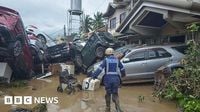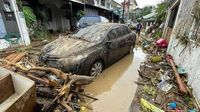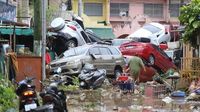Typhoon Kalmaegi tore through the central Philippines on November 4, 2025, leaving a trail of devastation, heartbreak, and uncertainty for hundreds of thousands of residents. As the 20th tropical cyclone to strike the archipelago this year, Kalmaegi proved to be one of the most punishing, with reports from BBC and The Associated Press confirming that at least 40 people have lost their lives, most of them to flash floods that submerged entire towns and swept away homes, vehicles, and livelihoods.
The storm’s wrath was felt most acutely in Cebu province, the country’s most populated central island. According to provincial governor Pamela Baricuatro, "The situation in Cebu is really unprecedented. We were expecting the winds to be the dangerous part, but... the water is what’s truly putting our people at risk. The floodwaters are just devastating." Videos and images circulated by international outlets showed cars and shipping containers floating through city streets, while desperate residents took shelter on rooftops, waving for help as muddy torrents surged below.
Kalmaegi, locally named Tino, made landfall shortly before midnight on November 3, bringing sustained winds of 130 kilometers per hour (81 mph) and gusts up to 180 kph (112 mph), as reported by disaster response officials and the state weather service. The typhoon’s impact was so severe that even some designated evacuation centers in Cebu were inundated, forcing people to seek safety wherever they could find higher ground. Rhon Ramos, an information officer on Cebu, told AFP, "People marooned on rooftops are asking to be rescued," but added that rescue operations were hampered by the extent of the flooding and debris.
Before Kalmaegi’s arrival, authorities had already evacuated nearly 400,000 people from its projected path, a figure confirmed by Rafaelito Alejandro, deputy administrator of the Office of Civil Defence. The mass evacuation was a grim echo of the country’s disaster-prone reality: the Philippines is battered by around 20 typhoons and storms each year, often with catastrophic results. The memory of Super Typhoon Haiyan in 2013, which left more than 7,300 people dead or missing, still haunts many communities.
The human toll from Kalmaegi was compounded by tragedy in the air. As the storm battered the central islands, a Philippine Air Force Super Huey helicopter dispatched to deliver humanitarian aid crashed near Loreto town in Agusan del Sur province on Mindanao. The military’s Eastern Mindanao Command reported that all six crew members perished in the accident. “Communication with the helicopter was lost, which immediately prompted the launch of a search and rescue operation,” the Philippine Air Force stated, later confirming the recovery of the bodies. The cause of the crash remains under investigation, but it underscored the perilous conditions faced by both victims and rescuers alike.
Flooding was the deadliest aspect of Kalmaegi’s rampage. Most fatalities occurred in Cebu, where torrents of muddy water surged down hillsides and into urban neighborhoods, sweeping away small buildings and blanketing streets in thick mud. In Southern Leyte, an elderly villager drowned, while in Bohol province, a man was killed by a falling tree—a testament to the storm’s ferocity. Danilo Atienza, a disaster official, confirmed these deaths, and provincial authorities warned that the casualty count could rise as more reports come in from isolated communities.
The storm’s impact was not limited to loss of life. Infrastructure across the region took a severe beating. Residential areas in Cebu saw extensive damage, with many homes destroyed or rendered uninhabitable. Rescue teams took to boats to reach people trapped inside their houses, and cars were seen floating or piled up in heaps after being swept away by the floodwaters. The Philippine Red Cross secretary-general, Gwendolyn Pang, described the chaos: “We have received so many calls from people asking us to rescue them from roofs and from their houses, but it’s impossible. There are so many debris, you see cars floating so we have to wait for the flood to subside.”
The logistical challenges extended to transportation and commerce. The coast guard prohibited interisland ferries and fishing boats from venturing out, stranding more than 3,500 passengers and cargo truck drivers at nearly 100 seaports. At least 186 domestic flights were canceled, further complicating relief efforts and leaving many travelers in limbo. The disruption was particularly acute in regions still reeling from previous disasters: Cebu, for instance, was just beginning to recover from a 6.9 magnitude earthquake that struck on September 30, killing at least 79 people and displacing thousands.
In Eastern Samar, one of the first provinces lashed by Kalmaegi, the story was slightly different. While fierce winds ripped off the roofs of about 300 rural shanties on Homonhon Island, Mayor Annaliza Gonzales Kwan told the AP, “There was no flooding at all, but just strong wind. We're OK. We’ll make this through. We’ve been through a lot, and bigger than this.” Her resilience echoed across the region, even as memories of past disasters—like the devastation wrought by Typhoon Haiyan—remained fresh.
As Kalmaegi moved westward at 25 kilometers per hour (16 mph), forecasters predicted it would exit into the South China Sea by early November 5, sparing the western province of Palawan the worst of its winds and rain. Yet, with the typhoon season far from over, state weather specialists warned that three to five more storms could form before the end of December. Charmagne Varilla of the state weather service pointed to larger forces at work: “Higher numbers of cyclones typically accompany La Nina,” she explained, referencing the climate pattern that cools Pacific surface temperatures. Scientists, as reported by AFP, have also linked the increasing frequency and intensity of storms in the region to human-driven climate change—a reality that leaves the Philippines especially vulnerable.
The latest disaster comes on the heels of a particularly brutal year for the Philippines. Back-to-back typhoons in September—Super Typhoon Ragasa and Typhoon Bualoi—had already left a trail of destruction, while an extraordinarily wet monsoon season sparked widespread flooding and public outcry over unfinished flood control projects. The cumulative effect of these disasters has left many Filipinos exhausted, angry, and anxious about the future.
As rescue and recovery efforts continue, the stories from the ground paint a picture of both immense hardship and remarkable resilience. Don del Rosario, a resident of Cebu City, summed up the sentiment for many: “I've been here for 28 years, and this is by far the worst we've experienced.” With the storm now moving on and the floodwaters slowly receding, communities across the central Philippines are left to pick up the pieces—once again.


